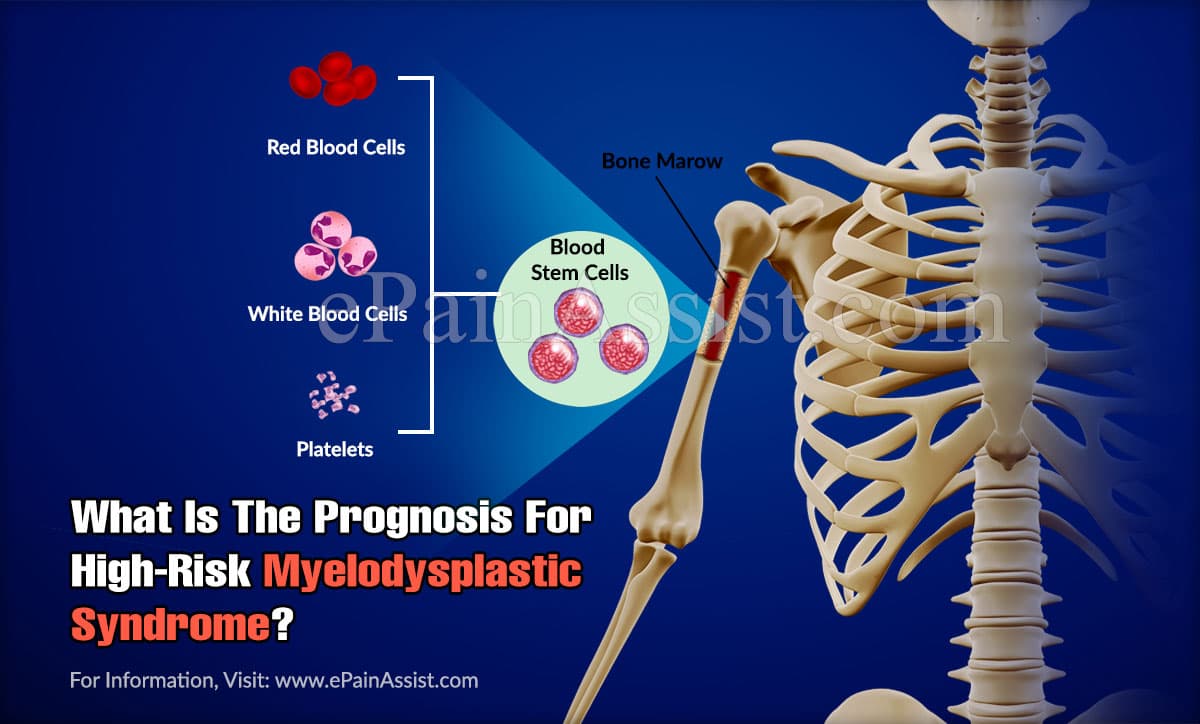High-risk myelodysplastic syndrome is the condition has unfavorable prognosis as this is the advanced stage of this disease. Further, people with the high-risk condition are at increased risk of developing acute myeloid leukemia.

What Is The Prognosis For High-Risk Myelodysplastic Syndrome?
The survival rate and the prognosis of the myelodysplastic syndrome depend upon a variety of factors. Factors affecting the survival include the stage of the disease, its progression into AML, age of the patient and the patient’s response towards the treatment. The International Prognostic Scoring System (IPSS-R) divided the patient into risk groups on the basis of various factors. The risk groups are very low, low, intermediate, high and very high and their median survival is 8.5 years, 5 years, 3 years, 1.5 years and 0.8 years, respectively. Another scoring system, WHO Prognostic Scoring System (WPSS) risk groups, also calculates the median survival and the risk of AML in next 5 years after diagnosis. The median survival is approximately 12 years, 5.5. years, 4 years, 2.2 years and 9 months respectively for the similar category as defined under International Prognostic Scoring System.(2)(3)
Treatment Of Myelodysplastic Syndrome
Myelodysplastic syndrome is a difficult condition to treat. The condition can only be cured through stem cell transplantation but has its own limitations. The aim of the treatment is to manage the symptoms of the disease and delay the progression of the disease. The myelodysplastic syndrome has a high risk of progression into acute leukemia. The disease can be kept in the remission stage by adopting a combination of various treatment options. Following are the treatment options available with the oncologists to treat the patient suffering from this condition:
Chemotherapy– Chemotherapy is the first line therapy in managing the myelodysplastic syndrome. Various drugs are available that reduces the growth of malignant cells while improving the number of healthy cells. Although the treatment is effective but temporary as the condition may recur after discontinuation of the treatment. Chemotherapy is also used in stem cell transplant to kill all the malignant cells. Drugs which are generally used in myelodysplastic syndrome are daunorubicin, topotecan, mitoxantrone, and fludarabine.
Medications- Various medications are used to manage the symptoms of myelodysplastic syndrome. This medication helps increase the blood cells. Further, this helps to control the genes that promote the growth of malignant cells. Also, these also function like chemotherapy drugs and kills cancerous cells. These medications are included in hypomethylating agents and include azacytidine and decitabine. Lenalidomide is another drug that is also used in the treatment of this condition.
Growth Factors- The major symptoms in this condition occur due to the low level of blood cells. These growth factors stimulate the bone marrow to produce blood cells. These growth factors are, thus, known as a hemopoietic growth factor. The growth factor for increasing the number of RBC is Erythropoietin, while the advanced long active form of erythropoietin is Darbepoetin alfa. The granulocyte colony stimulating factor and granulocyte macrophage-colony stimulating factor are the growth factors that increase the number of WBC. Patient effectively responding to these treatments have a low frequency of blood transfusions.
Blood Transfusions- Blood transfusion is required when the number of blood cells is at a critically low level and severe symptoms are experienced by the patients. Such patients have severe breath shortness and are at high risk of bleeding.
Stem Cell Transplant– Stem cell transplant is the technique to cure this condition. Although highly effective, this technique is limited only to some patients. This is because, prior to stem cell transplant, chemotherapy and radiotherapy are used to kill all the stem cells. These processes have their own side effects.(1)
Conclusion
Patients with the high-risk myelodysplastic syndrome have a poor prognosis with severe symptoms and there is a significantly higher risk of progression into AML. The median survival of the patients of this group is approximately 9 months and the risk of progressing the condition to AML is 84%.
- https://www.hopkinsmedicine.org/kimmel_cancer_center/types_cancer/myelodysplastic_syndrome.html
- https://www.cancer.org/cancer/myelodysplastic-syndrome/detection-diagnosis-staging/survival.html
- https://www.cancer.ca/en/cancer-information/cancer-type/leukemia/leukemia/myelodysplastic-syndromes/?region=on#treatments
Also Read:
- Coping with Myelodysplastic Syndromes & its Follow-Up Care
- What Are Early Signs Of Myelodysplastic Syndrome?
- What To Eat & Avoid When You Have A Myelodysplastic Syndrome?
- Does Myelodysplastic Syndrome Ever Go Away?
- Does Myelodysplastic Syndrome Cause Weight Loss?
- Is Myelodysplastic Syndrome Genetic?
- Are There Any Alternative Ways To Treat Myelodysplastic Syndrome?
